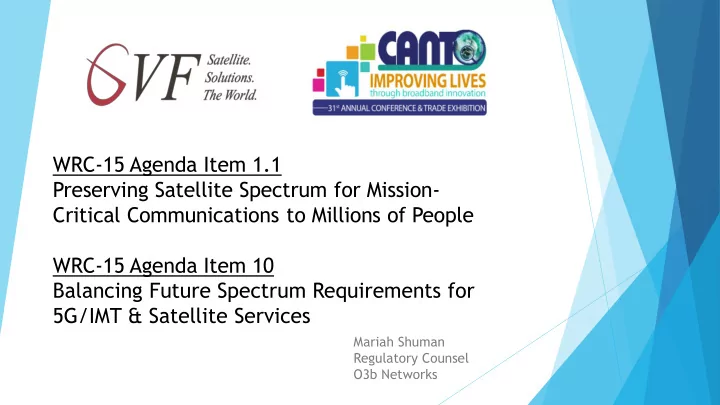

WRC-15 Agenda Item 1.1 Preserving Satellite Spectrum for Mission- Critical Communications to Millions of People WRC-15 Agenda Item 10 Balancing Future Spectrum Requirements for 5G/IMT & Satellite Services Mariah Shuman Regulatory Counsel O3b Networks
Global VSAT Forum GVF is an independent, non-partisan and non-profit organization with 200+ members from every major region of the world GVF membership represents every sector of the satellite industry Including fixed and mobile satellite operators, satellite network operators, teleports, satellite earth station manufacturers, system integrators, value added and enhanced service providers, telecom carriers, consultants, law firms, and users
O3b System Overview Overview MEO: 8,062km altitude 3
Satellites Support Mobile Services Satellite continues to develop new services Enhance mobile capacity and coverage Strengthen the resiliency and diversity of the telecommunications ecosystem Multiple elements of a telecommunications ecosystem – fiber, mobile, satellite – are needed to get ICT to end users Satellite is ideal for areas that are „non - viable‟ for terrestrial technologies Satellite can support extension of terrestrial networks into previously 4 unserved areas
MEVA Regional Communications C-band Satellite Network in the Caribbean Critical aeronautical and meteorological information High reliability essential for aviation operations Introduction of IMT in C-band would place critical communications at risk Equipment replacement and modification is costly
WRC-15 Agenda Items 1.1 & 10 WRC-15 Agenda Item 1.1: to consider additional spectrum allocations to the mobile service on a primary basis and identification of additional frequency bands for International Mobile Telecommunications (IMT) and related regulatory provisions, to facilitate the development of terrestrial mobile broadband applications, in accordance with Resolution 233 (WRC-12) Under consideration is additional spectrum generally for IMT and other mobile broadband applications in 3400-4200 MHz (C-band) WRC-15 Agenda Item 10: to recommend to the Council items for inclusion in the agenda for the next WRC, and to give its views on the preliminary agenda for the subsequent conference and on possible agenda items for future conferences, in accordance with Article 7 of the Convention Under consideration is which, if any, frequency bands to study for allocation to IMT in the future (such as Ka-band)
GVF Position on Agenda Item 1.1 C-band satellites support a wide variety of applications (such as video distribution and point of sale for banking, gas, etc.) and provide critical communications services throughout the Caribbean and the world C-band is unique in terms of its physical properties, providing supreme availability and wide-area coverage that cannot be matched in other bands To retain the full benefits of C-band services, sound spectrum management policies must be employed This includes preservation of C-band satellite spectrum The wireless industry has available spectrum to utilize, and there is uncertainty regarding predictions of additional spectrum needs for IMT Past implementation experience and recently approved ITU studies have shown that in- band or adjacent band operation of IMT will cause harmful interference to incumbent satellite services Particularly in the 3400-4200 MHz receive band Existing and future C-band satellite services must be protected from IMT spectrum demands via “No Change”
GVF Position on Agenda Item 10 It is unreasonable to propose studies in a wide range of spectrum (such as “above 6 GHz”) The technical characteristics of the proposed IMT services are undefined, which renders studies about allocation to be premature There are existing critical systems that have already been designed and extensively deployed in the bands above 6 GHz These bands include incumbent services (such as satellite services in Ka-band) that are expanding to address growing demands for broadband and for mobile connectivity As an essential part of broadband connectivity, these bands are not good candidates for the additional constraints that must be considered with the introduction of mobile services For example, O3b is enabling 2G, 3G and 4G connectivity to a number of markets in Latin America, Africa, Asia, the Middle East, the Pacific, and the Caribbean Sharing scenarios are likely to impose significant constraints on existing users in bands already in extensive use below 31 GHz
Conclusions Existing and future C-band satellite services must be protected from unsupported IMT spectrum demands via “No Change” on Agenda Item 1.1 For further information contact David Hartshorn (GVF Secretary General) Agenda Item 10 sets the foundation (and obligations) for the next 4 years Existing services must be protected and allowed to grow It is important to set realistic and practical goals, and to make the best use of everyone‟s time and resources IMT community must identify specific candidate bands, above 31 GHz, and provide clear definition of their systems in order to conduct meaningful studies after WRC-15
Recommend
More recommend